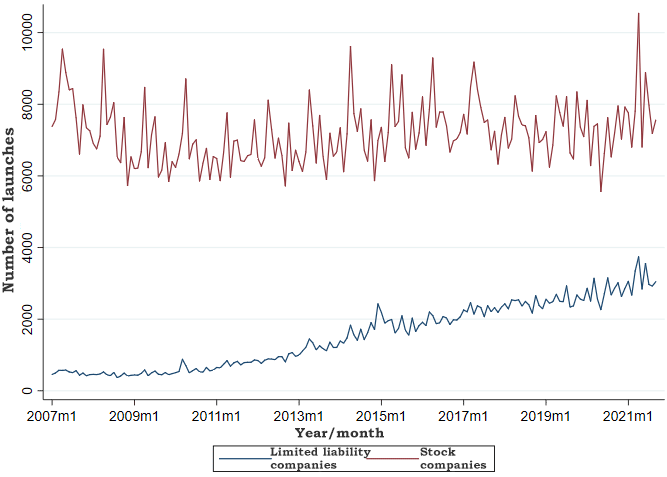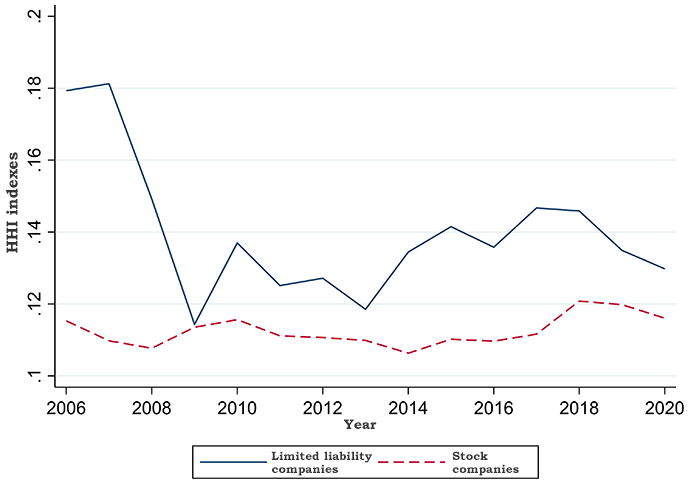Diversity is an important concept for human society as well as ecosystems. Diversity should be proactively preserved as far as it produces new value. Recent business start-ups in Japan include many limited liability companies in addition to conventional joint stock companies.
Birth of Japanese LLCs and background
As the Companies Act came into effect in May 2006 in Japan, limited liability companies (LLCs) began to be launched as a new form of company. The LLC was designed as an organization that gives priority to human assets under limited liability. As the company form was modeled after the limited liability company in the United States, it is frequently called the Japanese LLC. When LLCs were born, the traditional form of private limited company was abolished. Since then, Japan has had four major company forms – joint stock companies, general partnership companies, limited partnership companies and limited liability companies (Note 1). Table 1 shows the characteristics of the four company forms.
| Stock company | Limited liability company | General partnership company | Limited partnership company | |
|---|---|---|---|---|
| Investors | Shareholders | Members | Partners | Partners |
| Organization/liability | Limited liability | Limited liability members | Unlimited liability partners | Limited and unlimited liability partners |
| Decisionmaker | General shareholders' meeting | General members' meeting | Partners' general meeting | Partners' general meeting |
| Source: Prepared by the author from Mizuho Securities Co. "money_campus" (Japanese), etc. https://money-campus.net/archives/1300 [Accessed on December 1, 2021] |
||||
The Japanese LLCs attracted attention, but initial LLC launches were sluggish. After 78,293 private limited companies were founded in 2005, only 3,392 LLCs were launched in 2006 and 6,076 LLCs in 2007 (Note 2). Although there were high expectations for the new company form, the number of LLC launches was disappointing.
One reason for the sluggish initial LLC launches was that the minimum capital system for joint stock companies was abolished at the same time. Since April 1991, the minimum capital requirement had been set at 10 million yen for a joint stock company and 3 million yen for a private limited company. As the Companies Act was implemented, which abolished the minimum capital system for joint stock companies, leading to the establishment of an exceptional number of companies capitalized with only 1 yen in holdings. The number of joint stock company launches increased substantially from 23,228 in 2005 to 76,570 in 2006.
Increasing LLCs
As LLC launches stagnated, joint stock companies were expected to effectively dominate the business world. Contrary to expectations, however, new LLCs emerged. A number of famous LLCs have emerged, including Crimson Group, owned by the founder of Rakuten Inc., which changed from a joint stock company to an LLC. Some foreign companies' Japanese subsidiaries, including Apple Japan LLC, have been established as LLCs. Not only small human capital-based companies, but also large multinationals like Apple, have chosen to be established as LLCs.
Figure 1 shows the monthly numbers of LLC and private limited company launches. While the number of joint stock company launches has remained within a certain range, the number of LLC launches has continued its uptrend since around October 2010 (Note 3). In some months after 2019, the number topped 3,000. The uptrend indicates a robust spread of LLCs (Note 4). Even amid the spread of COVID-19 infections since March 2020, no major drop has been seen in the monthly number of LLC launches.

A simple regression equation is used here to estimate the monthly number of LLC launches to describe the uptrend. The regression equation includes the monthly number of LLC launches between October 2010 and September 2021 as a dependent variable and the trend term (limited to the primary term) as an independent variable. The equation projects the future monthly numbers of LLC launches (Note 5). According to the regression equation, the number of LLC launches in January 2027, five years from now, will come to 4,379.
If the number of joint stock company launches remains at the past average level, the number of LLC launches may top that of joint stock company launches in May 2039, 17 years from now. Based on a regression equation including the number of joint stock company launches between January 2007 and September 2021 as a dependent variable and the trend term as an independent variable, the number of LLC launches may exceed that of stock company launches in February 2043. If LLCs increase at the present pace, LLCs may become dominant among the current company forms.
LLCs spreading to rural regions
Company launches may differ by region. Around the 2000s, information technology (IT) start-ups concentrated in some urban areas including the Shibuya Ward of Tokyo amid an IT boom. As such, LLC launches might have been limited to urban regions.
I broke down annual LLC launches by prefecture. As expected earlier, Tokyo posted the largest share, accounting for more than 40% of LLC launches in 2007 (Note 6). Later, however, LLC launches were not necessarily concentrated in specific regions such as Tokyo.
To demonstrate this, I computed each prefecture's share of company launches and the Herfindahl-Hirschman Index (hereinafter referred to as "HHI index"), indicating the extent of concentration of company launches in some prefectures. Figure 2 shows the annual HHI index for LLCs and joint stock companies. The extent of concentration in some regions was high in 2006 and 2007 just after the birth of LLCs, but it declined later. The extent of concentration in some regions for LLCs is higher than for joint stock companies. Compared with years just after the birth of LLCs, however, the extent of concentration has been lower in some regions. This indicates that LLCs have begun to spread in numerous regions.

Characteristics of LLCs
LLC members (directors), like stock company members, have limited liability. Their liability is limited to their investment sizes, meaning that personal assets can be protected even with risky business LLCs. Unlike joint stock companies, LLCs are not required to have their articles of incorporation certified. The registration and license tax for LLCs is lower than for stock companies, indicating an advantage for LLCs.
The biggest difference between LLCs and joint stock companies is seen in ownership and management. At stock companies, shareholders as company owners are separated from company managers. At LLCs, however, members undertake both ownership and management responsibilities. The separation of ownership and management provides some advantages. Joint stock companies can raise funds (to increase their capital size) through new share issuance, without giving management rights to shareholders. They can transfer ownership smoothly through sales of shares.
However, most small and medium-sized enterprises or start-up companies have no need to separate ownership and management. Companies that do not need to raise funds or transfer ownership do not have to be joint stock companies. In fact, in order to prevent takeovers or resales, it is better for companies not to separate ownership and management. LLC members can agree to share profits in a manner that is not proportional to their investment sizes. However, ownership and profit sharing changes can trigger dispute, so asset management companies or Japanese companies in general do not want to invite such changes, which is a source of reluctance towards creating LLCs in Japan.
Toward launching diverse companies
People are aging in Japan, but so are companies. While Meta Platforms Inc. (formerly Facebook), Tesla Inc. and some other U.S. companies that are younger than 20 years old are ranked high in market capitalization globally, Toyota Motor Corp. with the highest market capitalization in Japan is more than 80 years old. In Japan, the hope for the future of the economy rests on the shoulders of fast-growing start-ups with large economic impacts. Policy support should be given to such start-ups to produce economic effects. However, not all companies can realize growth and only a handful of start-ups reach the initial public offering stage (Honjo, 2021).
As society is diversified, the way should be paved for a diverse range of companies to be launched. It is not necessary to force all the start-ups to grow nor for support with policies to have the same effects on them. Rather, it is important to select which start-ups are appropriate for support. The separation of ownership and management has been seen as a must for company growth, it but may actually be a useless system for some companies that do not need to raise funds or expand.
In addition to LLCs, various other forms of businesses are being launched, including limited liability partnerships and freelance companies. An environment for maintaining diversity is desirable, if it is not too costly to maintain such institutional frameworks. I would like to see a large diversity of companies being created in the near future.


